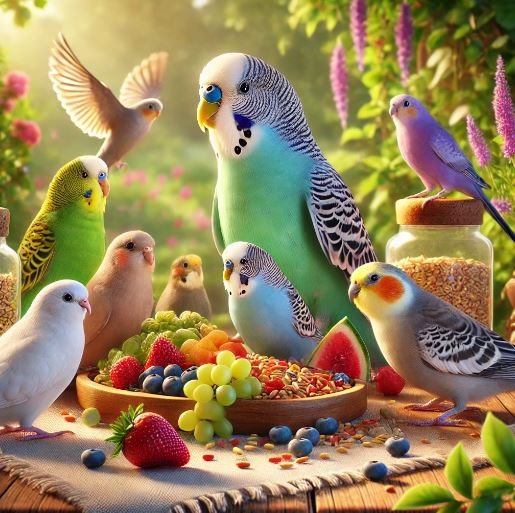Can Birds Eat Pinto Beans? Parrots, Budgies, Cockatiels plus Recipe
Can Birds Eat pinto beans? Yes, birds can eat pinto beans, including parrots, budgies, and cockatiels, but there are important precautions to take:

Important Considerations:
- Cooked Only: Pinto beans must be thoroughly cooked before being fed to birds. Raw or undercooked beans contain lectins, which are toxic to birds (and humans). Cooking destroys these harmful compounds.
- No Additives: Cook the beans without any added salt, seasoning, or oils. These additives can be harmful to birds.
Benefits of Pinto Beans:
- High in Protein: Pinto beans are a good source of plant-based protein, which is essential for muscle development and overall health.
- Rich in Fiber: The fiber in pinto beans supports digestive health.
- Contains Essential Nutrients: Pinto beans provide vitamins such as folate and minerals like iron, magnesium, and potassium.
Can Birds Eat pinto beans? Feeding Guidelines:
- Portion Size:
- For parrots, a few cooked pinto beans can be mixed into their regular diet.
- For budgies and cockatiels, offer smaller portions, such as half a bean chopped into small pieces.
- Serving Ideas:
- Mixed with Vegetables: Combine cooked pinto beans with chopped vegetables like carrots, sweet potatoes, and leafy greens for a balanced meal.
- Mash and Mix: Mash the beans and mix them with grains or pellets for easier consumption, especially for smaller birds.
- Moderation: Pinto beans should be offered in moderation as part of a varied diet. They should not be the primary food source but rather a nutritious addition.
Can Birds Eat pinto beans? Conclusion:
When prepared properly, pinto beans can be a healthy and nutritious treat for parrots, budgies, cockatiels, and other pet birds. Just ensure they are thoroughly cooked and free from any additives to keep your feathered friends safe and healthy.
Here’s a simple and nutritious recipe using pinto beans, suitable for parrots, budgies, and cockatiels. This recipe combines pinto beans with other healthy ingredients to create a balanced and tasty meal for your birds.

Pinto Bean Veggie Mix Recipe
Ingredients:
- 1/4 cup cooked pinto beans (thoroughly cooked and unsalted)
- 1/4 cup cooked quinoa (or brown rice)
- 1/4 cup chopped carrots (steamed or lightly boiled)
- 1/4 cup chopped sweet potato (steamed or lightly boiled) or parsnip
- 1/4 cup chopped bell pepper (red, yellow, or green)
- 1 tablespoon chopped spinach or kale (optional, for added greens)
- 1 teaspoon ground flaxseed (optional, for omega-3 fatty acids)
- 1/4 teaspoon ground turmeric (optional, for additional health benefits)
Instructions:
- Cook the Pinto Beans:
- Thoroughly cook the pinto beans until they are soft. Ensure they are free from any additives like salt, seasoning, or oil. Let them cool to room temperature.
- Cook the Quinoa or Brown Rice:
- Cook the quinoa or brown rice according to the package instructions. These grains add protein and essential nutrients. Allow them to cool.
- Prepare the Vegetables:
- Steam or lightly boil the chopped carrots and sweet potato until they are tender but not mushy.
- Chop the bell pepper and any leafy greens you are using (spinach or kale) into small, bird-friendly pieces.
- Mix the Ingredients:
- In a large bowl, combine the cooked pinto beans, quinoa (or brown rice), and the prepared vegetables.
- If using, sprinkle the ground flaxseed and turmeric over the mixture.
- Stir everything together until well combined.
- Serving:
- Offer small portions to your birds. You can place the mix in their food dish or use it as a foraging treat by hiding small amounts in foraging toys.
- Adjust portion sizes according to the size of your bird. Larger parrots will need more, while smaller birds like budgies and cockatiels will need less.
- Storage:
- Store any leftovers in an airtight container in the refrigerator for up to 3 days. For longer storage, portion out the mix and freeze it in small servings, then thaw before serving.
Nutritional Benefits:
- Pinto Beans: Provide plant-based protein, fiber, and essential minerals like iron and potassium.
- Quinoa/Brown Rice: Adds protein and essential amino acids.
- Carrots and Sweet Potatoes: Rich in beta-carotene (vitamin A) for vision and immune support.
- Bell Peppers: High in vitamin C, which supports immune health.
- Spinach/Kale: Offers additional vitamins like vitamin K and calcium.
- Flaxseed: Adds omega-3 fatty acids for healthy skin and feathers.
- Turmeric: Provides anti-inflammatory benefits.
Can Birds Eat pinto beans? Feeding Tips:
- Moderation: This mix should be offered as part of a varied diet. It’s nutritious, but variety is key to a balanced diet.
- Introduction: Introduce new foods gradually to ensure your birds accept them and don’t experience digestive issues.
- Observation: Always observe your birds when introducing new foods to ensure they enjoy the mix and it agrees with them.
This pinto bean veggie mix is a wholesome and delicious way to add variety and nutrition to your birds’ diet. Adjust the ingredients to suit your birds’ preferences and needs, and enjoy watching them savor this healthy treat!
Can Birds Eat pinto beans? Info-table
| Name: |
| Pinto bean |
| Scientific name: |
| (many varieties) |
| Also known as: |
| Indigenous Countries: |
| Description: |
| Legume |
| Nutritional Value: |
| Contains many essential nutrients and is exceptionally low in saturated fat. It is a good source of protein, phosphorus, and manganese, and is very high in dietary fibre and folate. |
| Feeding: |
| Fully cooked – how to cook Pinto Beans |


